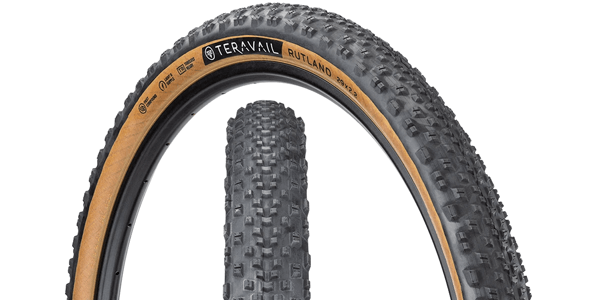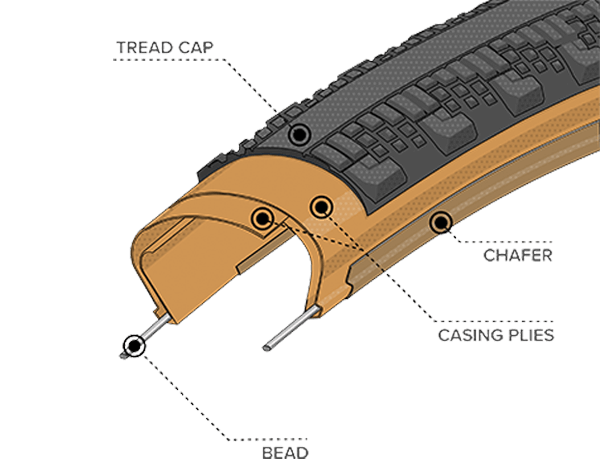THE BEST BIKE TIRES FOR GRAVEL: A TERAVAIL GUIDE
May 20, 2021

Gravel riding means a lot of different things to a lot of different people—every rider has their own goals, their own bikes, and their own local terrain. Faced with the huge range of tires intended to excel in every possible gravel situation, you might find it tricky to choose the perfect tire.
Because everyone has unique needs, we’ve created this basic guide to picking the best bike tires for gravel riding, whatever that means to you.
TREAD PATTERN
Let’s start with the type of terrain you'll ride most of the time. Is it hard-packed gravel? Smooth pavement? Rough forest service roads? Technical singletrack? Tread patterns are typically designed to perform on particular surfaces, so they're worth paying attention to.
In a perfect world, riders would swap tires every ride to fit the terrain and conditions. But in the real world, it's best to find a tire that’s optimal for the majority of your riding situations. We make tire designs for all types of terrain, so consider which tread pattern best suits the way you ride.
Here’s a look at our gravel tire recommendations based on terrain mix:
RAMPART
Best on: Pavement / Hard-Packed Gravel / 700c / 650b
- Categorized as an “all-road” tire, Rampart offers a fast rolling, smooth ride quality feel for those looking to stay mostly on the pavement.
- Rampart’s center tread is smooth and fast-rolling for straight-line speed; the thicker center tread and durable casing lasts longer even on harsh surfaces. The shoulder of the tire consists of incremental siping for dependable cornering traction in variable conditions.

WASHBURN
Best on: Pavement / Hard-Packed Gravel / Loose Gravel / 700c / 650b
- Known as our fastest-rolling gravel tire, Washburn uses a center slick for maximum rolling efficiency, paired with elevated side lugs for additional cornering confidence.
- Washburn’s center slick minimizes rolling resistance for greater speed and momentum, while the transition knobs and raised side lugs are spaced out to provide cornering traction and shed debris.

CANNONBALL
Best on: Pavement / Hard Packed Gravel / Loose Gravel / Singletrack / 700c / 650b
- The go-to all-arounder, Cannonball features an ideal balance of grip, minimal rolling resistance, and cornering traction for a confidence-inspiring feel without compromising speed.
- Directional, tight-knit center tread efficiently decreases rolling resistance while the side knobs increase cornering traction. The center tread’s diamond pattern is optimized specifically for gravel riding and sheds dirt and gravel debris.

RUTLAND
Best on: Loose and Chunky Gravel / Wet Gravel / Singletrack / 700c / 650b / 29" / 27.5"
- Designed for rough and loose terrain, Rutland offers maximum grip, tire protection, and off-the-beaten-path capability for pushing limits.
- Rutland features ramped, tightly spaced center lugs that reduce rolling resistance while more aggressive shoulder and transition lugs provide grip in loose conditions.

SPARWOOD
Best on: Singletrack / Loose Gravel / Hard Packed Gravel / 29" / 27.5"
- For 27.5" and 29" riders, Sparwood is a fast-rolling do-it-all tire ready for bikepacking, gravel riding, and everything in between.
- Sparwood’s center lugs are raised and ramped for rolling efficiency. Diamond- and chevron-shaped transition lugs are staggered to improve shedding and traction, while L-shaped side lugs dig in for grip while braking through corners.

TIRE CASING
Once you’ve selected your tread pattern, it’s time to think about tire casings—the layers of material that the tire tread sits on and around. The internal layers and makeup of the casing are important factors in how the tire feels, rides, and performs.
We offer two different gravel tire casings:
- Durable Bead-to-Bead offers a robust composition with a woven nylon layer in the sidewall and tread cap to protect the tire against punctures, abrasions, and lacerations.

- Light & Supple rolls more comfortably and weighs less than its counterpart, though it offers less puncture protection.

Both casings have their benefits for different riding styles and priorities. Consider these factors when deciding between the two:
Rider and Gear Weight – Lighter loads typically exert less force on tires and thus require less reinforcement. Our Light & Supple casing offers a comfortable ride feel with ample stiffness at lower pressures on lightweight setups. When you’re loaded up for a tour or just riding with extra gear, our Durable Bead-to-Bead casing provides additional stability and reliability while maintaining a comfortable ride.
Riding Style – Some riders pick more aggressive lines, push harder into corners, or are generally rougher on their tires. Our Durable Bead-to-Bead casing can help those riders push the limits without suffering the consequences of getting a flat.
Intended Terrain – The type of gravel in the places you ride should also influence casing choice. Where the gravel is loose, sharp, chunky, or all of the above, you may want to consider the additional puncture protection of our Durable Bead-to-Bead casing.
TIRE COMPOUND
After you’ve selected the right casing for your riding conditions, it's time to consider compounds. A tire's compound is essentially the DNA of the rubber in the tire and how it’s designed.
We optimize each of our gravel tire tread patterns and casings for specific uses and terrain. Across all of those scenarios, we've found that 60a-durometer rubber brings out the performance of the tread pattern by providing an ideal balance of grip, abrasion resistance, and comfort.
But we don’t take a one-compound-fits-all approach. We designed Rampart, our all-road tire, with a dual-compound rubber construction for an optimal riding experience on pavement. A harder (70a durometer) rubber in the center of the tire helps minimize rolling resistance and tread wear, while a softer (60a durometer) rubber on the shoulder provides dependable grip when cornering in mixed road and gravel conditions.
Even though you don’t have to decide on a tire compound when choosing from Teravail’s gravel and all-road tires, we feel it’s important to share our compound choices and the thought processes behind them.
TIRE SIZE
The final step in choosing the best bike tires for gravel is picking a size.
First, check your bike's tire clearance measurement to figure out what width will fit in your frame and fork.

After that, you’ll be able to narrow down your choices to anything under your tire clearance maximum. Our gravel tires range from 28 mm to 47 mm wide (some bikes might even be able to fit our 2.1"+ mountain bike tires).
Wider tires are more stable at lower pressures, so they tend to be comfortable, dependable, and efficient on rough terrain. That's why we generally suggest looking at the wider end of your available size range for gravel riding. That said, the trade-off of a wider tire is that you’re pedaling more weight around—go narrower if weight is a priority.
Let's compare a 38 mm tire to a 42 mm tire, for example: you might lean toward the 38 mm tire if you’re going for maximum efficiency and speed; the 42 mm tire might be better if you’re more focused on comfort and stability.
That said, terrain plays a big factor in which tire size is “faster”. Super rough and loose gravel can be hard to ride on, so the extra confidence and stability of the 42 mm tire might make you quicker. On hard-packed gravel or pavement, however, the 38 mm tire would likely roll faster.
CONCLUSION
All-in-all, your tires make a huge difference in how comfortable you are, how fast you ride, and even how much fun you have. We’ve put a lot of thought into designing tires that maximize this trifecta of comfort, speed, and fun—we’re sure you’ll find something to love in our lineup. If you’re still uncertain about the best bike tires for gravel riding in your area, talk to your local Teravail Dealer for assistance.
We’d like to thank Chris Hatton, Carter Nieuwesteeg, and Nakoda Mason of the Fernie Gravel Grind team for their collaboration in developing this guide. Based in Fernie, British Columbia, Fernie Gravel Grind seeks to bring excitement to gravel biking and inspire healthier, more inclusive communities by connecting people through two wheels.
